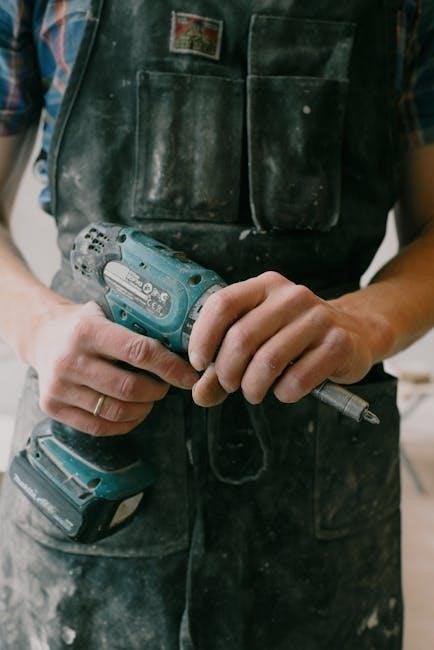dometic ac troubleshooting guide
Experiencing issues with your Dometic AC? This guide provides a systematic approach to diagnose and resolve common problems. We’ll cover initial checks, thermostat resets, and when to seek professional RV repair services.
Initial Checks and Preparations
Before diving into complex troubleshooting steps, perform these initial checks. First, ensure your RV is properly connected to a reliable power source, either shore power or a generator. Verify the voltage is within the Dometic AC’s specified range to prevent damage. Check all circuit breakers and fuses related to the AC unit, replacing any that are blown. Next, inspect the thermostat’s batteries and connections, ensuring they’re functioning correctly. Make sure the thermostat is set to “cool” mode and the desired temperature is lower than the ambient temperature inside the RV. Clear any obstructions around the AC unit’s exterior, such as debris or covers, to allow for proper airflow. Finally, familiarize yourself with your Dometic AC model’s specific manual for detailed instructions and safety precautions before proceeding with any further troubleshooting steps.
Understanding Common Dometic AC Problems
Dometic AC units can face issues like weak cooling, compressor failure, or fan malfunctions. Identifying the root cause is crucial for effective troubleshooting and repair.
AC Not Cooling Effectively
One of the most frequent complaints with Dometic AC units involves a lack of adequate cooling. This issue can stem from several underlying problems, impacting your RV’s comfort. Start by verifying that all zones are correctly configured and powered. Ensure the thermostat is properly set to “AC” mode and the desired temperature is significantly lower than the current room temperature. A common culprit is a dirty air filter, restricting airflow and reducing cooling efficiency. Regularly cleaning or replacing the filter is essential.
Furthermore, check for any obstructions blocking the exterior vents of the AC unit, hindering proper air circulation. In humid conditions, ensure the condensate drain is clear to prevent water buildup, which can also affect cooling performance. If these initial steps don’t improve the cooling, further investigation into the compressor, fan motor, or control board may be required.
Troubleshooting Steps
When your Dometic AC malfunctions, follow these troubleshooting steps to identify the problem. Start with the simplest solutions, like checking the thermostat, before moving to more complex issues.
Checking the Thermostat
Begin your Dometic AC troubleshooting by thoroughly examining the thermostat; First, ensure the thermostat is powered on and displaying correctly. Check the batteries if it’s battery-operated; low batteries can cause erratic behavior or a blank display. Verify that the thermostat is set to “cool” mode and that the desired temperature is lower than the current room temperature.
Confirm all zones are appropriately selected or deselected, ensuring no conflicts in the system’s operation. A common issue is accidentally having multiple zones active, which can confuse the AC unit. If the display is unresponsive or showing error codes, try resetting the thermostat. Often, a simple reset can resolve minor software glitches. To reset, switch the mode to off, then simultaneously press the mode and temperature up buttons until two dashes appear on the screen. This indicates a successful reset. If problems persist, a faulty thermostat might be the cause, and replacement may be necessary.
Inspecting the Condensate Drain
A crucial step in Dometic AC troubleshooting involves inspecting the condensate drain. The condensate drain removes moisture produced during the cooling process. A clogged drain can lead to water leaks inside your RV and reduce cooling efficiency. To inspect, locate the drain outlets, usually found on the exterior of your RV, beneath the AC unit. Check for any visible obstructions, such as dirt, debris, or algae growth.
If you don’t see puddles under the AC unit during humid weather, it’s a strong indicator of a blockage. Use a small wire or pipe cleaner to gently clear any obstructions from the drain openings. You can also use a wet/dry vacuum to suction out any debris. Pour a cup of diluted bleach or vinegar into the drain pan inside the RV to help dissolve stubborn clogs and prevent future growth. Ensure the A-frame is clear to allow proper drainage. Regularly cleaning the condensate drain will maintain optimal AC performance and prevent water damage.
Examining the Fan Motor and Capacitor
If your Dometic AC fan isn’t working, examining the fan motor and capacitor is essential. The fan motor is responsible for circulating air, and a faulty motor will prevent proper cooling. Start by visually inspecting the fan motor for any signs of damage, such as burnt wires or a swollen casing. Check the fan blades for obstructions that may be preventing them from spinning freely.
The capacitor provides the initial surge of power needed to start the fan motor. A failing capacitor is a common cause of fan motor issues. To test the capacitor, use a multimeter to measure its capacitance. If the reading is significantly lower than the rated value, the capacitor needs replacing. Also, ensure the control board is sending power to the fan motor. If the control board isn’t working, the fan won’t start. Replacing a faulty capacitor or fan motor can restore proper airflow and cooling.
Advanced Troubleshooting
When basic troubleshooting fails, advanced techniques are needed. This includes testing the compressor and checking the control board for faults. These steps often require specialized tools and expertise for accurate diagnosis.
Testing the Compressor
The compressor is a vital component of your Dometic AC system, and if it’s malfunctioning, it can lead to significant cooling issues. Before proceeding, ensure the unit is disconnected from the power source to prevent electrical shock. Begin by visually inspecting the compressor for any signs of damage, such as leaks, cracks, or burnt wiring.
Next, use a multimeter to test the compressor’s electrical continuity. Check the resistance between the terminals; an open circuit indicates a faulty compressor. You should also test the compressor windings for shorts to the ground. A reading other than infinite resistance suggests a ground fault.
Furthermore, consider using a compressor analyzer tool to assess its performance under load. This tool can measure the compressor’s starting and running amps, providing valuable insights into its overall health. If the compressor is drawing excessive current or failing to start, it may be time for a replacement. Remember safety first!
Checking the Control Board
The control board serves as the brain of your Dometic AC system, managing various functions such as fan speed and compressor operation. If you suspect the control board is faulty, a thorough inspection is necessary. Start by visually examining the board for any signs of damage, such as burnt components, loose connections, or corrosion.
Next, use a multimeter to test the input and output voltages of the control board. Verify that the board is receiving the correct voltage and that it’s sending power to the appropriate components, such as the fan motor and compressor. Consult the wiring diagram for your specific Dometic AC model to identify the correct test points.
If you find any discrepancies in the voltage readings or visible damage to the board, it may need to be replaced. Remember to disconnect the power before touching any components, and consult a qualified technician if you’re not comfortable performing these tests yourself.
Maintenance and Prevention
Preventative maintenance is key to extending the life of your Dometic AC. Regular cleaning, filter replacement, and leak checks can help avoid costly repairs and ensure optimal performance during travel.
Regular Cleaning and Filter Replacement
Maintaining a clean Dometic AC unit is essential for optimal performance and longevity. Dust and debris accumulation can significantly reduce cooling efficiency and strain the system’s components. Regular cleaning of the air filters is crucial, as dirty filters restrict airflow, forcing the AC to work harder and consume more energy.
Inspect the filters monthly, especially during periods of heavy use, and clean or replace them as needed. Washable filters can be cleaned with mild soap and water, while disposable filters should be replaced. Additionally, periodically clean the exterior of the AC unit to remove any accumulated dirt or debris.
A clean unit ensures better airflow, improved cooling, and reduced energy consumption. Neglecting this routine maintenance can lead to diminished performance and potential system failures, ultimately resulting in costly repairs.
Checking for Air Leaks and Insulation
Ensuring proper insulation and sealing air leaks is critical for maximizing the efficiency of your Dometic AC unit. Air leaks allow conditioned air to escape, forcing the AC to work harder to maintain the desired temperature. This results in increased energy consumption and reduced cooling performance.
Inspect the seals around windows, doors, and vents for any gaps or cracks. Use weather stripping or caulk to seal any leaks you find. Additionally, check the insulation in the walls and ceiling to ensure it is adequate and properly installed.
Poor insulation allows heat to penetrate the RV, making it more difficult for the AC to cool the space. Addressing air leaks and insulation issues will significantly improve the AC’s efficiency, lower energy costs, and create a more comfortable environment inside your RV. Regular inspections and maintenance are key to preventing these issues.
Resetting the Dometic Thermostat
Sometimes, a simple reset can resolve many issues with your Dometic thermostat. If your AC isn’t responding or the thermostat is displaying incorrect information, resetting it can often restore normal function. The reset procedure may vary slightly depending on the model, but a common method involves turning the thermostat off completely.
Then, simultaneously press and hold the “Mode” and “Up” temperature buttons. Continue holding these buttons until the display shows two dashes or briefly goes blank. This indicates that the thermostat has been reset.
Reconnect to shore power and turn the thermostat back on. Select your desired zone and set it to AC mode. Watch for an hourglass icon, signifying the system is initializing. Allow a few minutes for the AC to respond and begin cooling. If the problem persists after the reset, further troubleshooting may be necessary.
Professional Assistance
While many Dometic AC issues can be resolved with basic troubleshooting, some problems require the expertise of a qualified RV technician. If you’ve exhausted the troubleshooting steps and your AC still isn’t functioning correctly, it’s time to seek professional assistance.
Certified Dometic, GE, and Lippert RV technicians possess the knowledge and tools to diagnose complex problems, such as compressor failures, control board malfunctions, or refrigerant leaks. Attempting to repair these issues yourself can be dangerous and may void your warranty.
When seeking professional help, choose a reputable RV repair service with experience in Dometic AC systems. They can accurately identify the problem and perform the necessary repairs to restore your AC to optimal performance. Investing in professional assistance ensures the job is done correctly and prevents further damage to your RV’s cooling system.











Leave a Comment